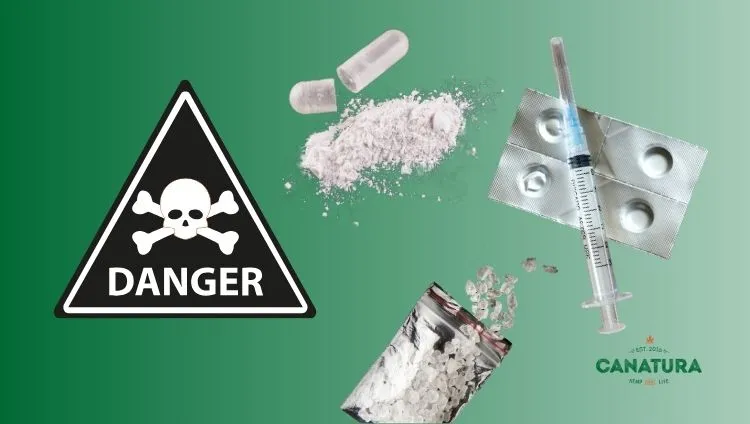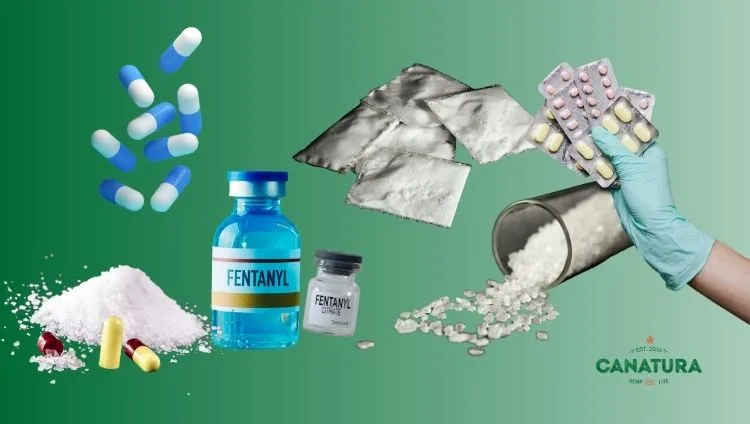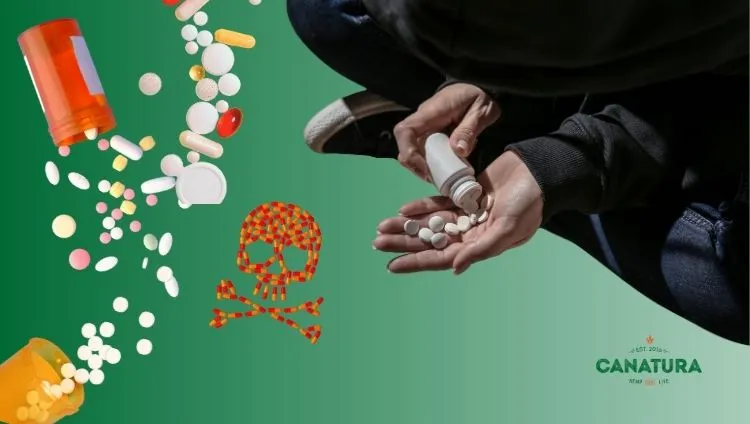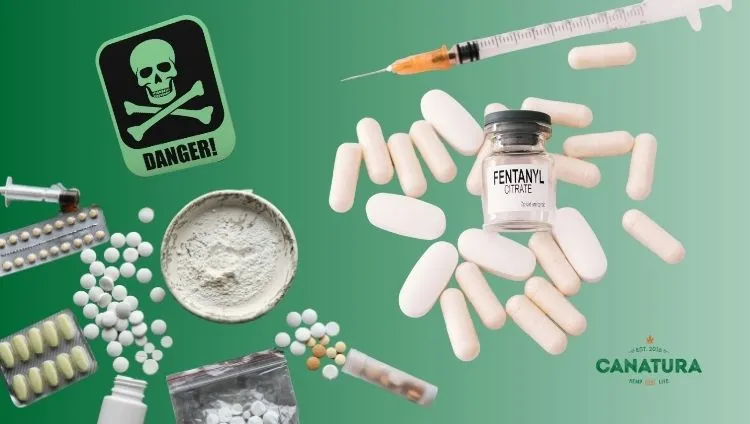New synthetic drugs in Europe – what to watch out for?
- What are new psychoactive substances (NPS)?
- The prevalence of new psychoactive substances in Europe in figures
- What are the risks associated with synthetic drugs?
- Table: Main effects of new psychoactive substances
- Synthetic stimulants (cathinones)
- Synthetic opioids
- New psychedelic drugs (hallucinogens)
- Other experimental psychoactive drugs
- Conclusion
- FAQ
What are new psychoactive substances (NPS)?
Novel Psychoactive Substances (NPS) are psychoactive substances that are not covered by international conventions on controlled narcotic and psychotropic substances.
They include a wide range of chemical compounds, from synthetic stimulants (imitating amphetamines, cocaine or ecstasy) to synthetic opioids (substitutes for heroin or painkillers) to new benzodiazepines with sedative effects and substances such as 7-hydroxymitragynine (7-OH) – a highly concentrated alkaloid from kratom.
The common denominator of these substances is that they are specifically designed or manufactured to circumvent existing drug laws, usually by slightly modifying the chemical structure of a known drug.
The emergence of new synthetic drugs in Europe in figures
Until 2024, new psychoactive substances (NPS) in Europe were monitored by the EMCDDA (European Union Drugs Agency), which was replaced on July 2, 2024 by the EUDA (European Union Drugs Agency).
The following table shows the number of newly reported substances in 2023–2024.
|
Year |
Total NPS monitored in the EU |
Total number of completely new substances |
Synthetic opioids |
Synthetic cathinones |
Other stimulants |
Psychedelics and others |
|
2023 |
950 |
26 |
7 |
4 |
3 |
10 |
|
2024 |
1,000 |
47 |
9 |
5 |
7 |
28 |
European Commissioner Ylva Johansson said during the EUDA presentation in 2024: “Criminals are constantly creating new drugs to avoid detection. Last year, this was mainly nitazene – a highly potent and extremely dangerous substance that led to deaths in Estonia and Latvia and caused poisonings in Ireland and France.”
What are the risks of synthetic drugs?
The risks of synthetic drugs lie in several factors:
- They have unknown and unpredictable effects on health.
- Substances are often confused or deliberately mixed: for example, synthetic cathinones have been found in Europe in the form of tablets sold as ecstasy.
- They are extremely potent: for example, some new synthetic opioids (nitazene, some fentanyl analogues) are more potent than fentanyl or heroin itself.
- Even microscopic amounts can cause overdose.
- Difficult detection: users may be under the influence of NPS and still pass routine checks, posing a risk in situations such as road traffic.
- Unstable composition and amateur production: illegal laboratories have no hygiene standards, so mixtures may contain toxic impurities, reaction by-products or completely different substances.
New synthetic drugs are dangerous not only because of their extreme potency and unknown composition, but also because they are often hidden in other drugs, which the user is unaware of.
In Europe, fatal poisonings associated with NPS have already been documented, e.g. in the United Kingdom, between June 1, 2023, and May 31, 2024, there were 179 deaths related to one or more nitazene.
Table: Main effects of new synthetic drugs
The table below provides an overview of selected new and risky psychoactive substances that have appeared in Europe in recent years.
|
Name |
Type of substance |
Main effects |
|
Synthetic stimulant (cathinone) |
Stimulation, euphoria, increased energy, rapid heartbeat, insomnia, risk of overdose |
|
|
Synthetic opioids (benzimidazole derivatives) |
Sedation, euphoria, analgesia, respiratory depression, high risk of overdose |
|
|
Experimental synthetic opioid from the spiropiperidine derivative group |
Strong analgesia, sedation, respiratory depression (in experimental use) |
|
|
Strong synthetic opioid |
Rapid onset of sedation, analgesia, euphoria, high risk of dependence and death |
|
|
(Semi)synthetic derivative of the alkaloid from kratom |
Pain relief, mild euphoria, sedation, sometimes nausea or confusion |
|
|
Sedatives/hypnotics – GABAergic substances |
Anxiety relief, sedation, memory impairment, drowsiness, risk of dependence |
Synthetic stimulants (cathinones)
The most widespread NPS production in Europe is the manufacture of synthetic cathinones, which are stimulants similar to methamphetamine.
Since 2017, at least 68 cathinone laboratories have been identified in the EU, mainly in Poland (77% of cases) and the Netherlands. The laboratories mainly produced mephedrone (4-MMC) and clephedrone (4-CMC), which were classified as controlled substances under international conventions in 2015 and 2020.
Clephedrone (4-CMC)
Clephedrone (chemically 4-chloromethcathinone) is a synthetic cathinone. It is a stimulant with effects similar to methamphetamine or cocaine. It often appears in tablets, usually as fake ecstasy (MDMA).
Clephedrone was first detected in Europe several years ago, but it has only recently gained significant attention due to its widespread production in Central Europe.
Risks ☠️: Similar to other stimulants, clefedrone carries a risk of overloading the cardiovascular system (it can cause arrhythmia, heart failure, or stroke due to overheating and dehydration). Intoxication manifests itself in panic, hallucinations, convulsions, a sharp rise in temperature, and possibly respiratory or cardiac arrest.
Other newly detected stimulants
Recently, other synthetic cathinones have been detected in Europe, such as:
- N-ethyl-norpentedrone (also known as NEP)
- Dipentylon (a derivative of pentylon)
- New variants of 3-CMC/2-MMC (replacing 3-MMC)
These substances are found in some European countries, mainly in tablets sold as ecstasy or in mixtures sold as cocaine or MDMA.
Risks ☠️: In general, synthetic cathinones are associated with acute intoxication – causing overheating, high blood pressure, heart failure, panic attacks or psychosis. Many cases of acute poisoning in emergency rooms in Europe are now linked to the use of these substances.

Synthetic opioids
Synthetic opioids are currently the most dangerous category of new psychoactive substances. These are extremely potent substances with effects similar to heroin or fentanyl – even small amounts can be fatal if overdosed.
Of particular concern are nitazenes and other highly potent substances that have already caused several fatal overdoses in the EU. In 2023, there was a sharp increase in nitazenes in the EU, with six new ones reported for the first time.
Nitazene
Nitazene is a group of synthetic opioids derived from 2-benzylbenzimidazole. It includes substances such as isotonicitazene, protonitazene, etonitazene, metonitazene and others.
In several European countries, fake pills of well-known drugs have been discovered that were laced with nitazene, e.g. Xanax (alprazolam), OxyContin (oxycodone) and Subutex (buprenorphine).
There have been outbreaks of poisoning and deaths linked to nitazene, with a sharp rise in deaths in Estonia and Latvia and local waves of overdoses in France and Ireland.
In the United Kingdom, at least 65 people died between summer and autumn 2023 as a result of using counterfeit medicines. In October 2023, British police seized around 150,000 nitazene tablets from an illegal pill press in London.
In the Czech Republic, the National Drug Headquarters (NPC) warned of the first findings of nitazene in the field in 2025. At the end of April 2025, the first known deaths in the Czech Republic caused by nitazene occurred – two men died and a third person was saved thanks to the intervention of doctors.
Nitazenes are opioid agonists that act on mu-opioid receptors in a similar way to heroin, morphine and fentanyl. Experts warn that some nitazenes can be up to 100 to 1,000 times stronger than morphine.
Risks ☠️: The main risk is overdose with respiratory failure. Nitazene can suppress the respiratory centre to such an extent that the affected person stops breathing and dies of oxygen deprivation without timely assistance.
Spirochlorofine (R-6890)
Spirochlorophine (R-6890 or Spirochlorphine) is a synthetic opioid from the group of so-called spiropiperidine analogues. It appears on the market as a “research chemical“. Chemically, it is a substance related to brorphine, a new opioid discovered in 2019.
Animal studies have shown that both brorphine and its analogue chlorphine have effects on opioid receptors comparable to those of fentanyl, which is why they are classified as very strong opioids. If fentanyl is about 50 times stronger than heroin, then substances such as spirochlorofine have a similar potential.
Spirochlorofine causes deep analgesia (pain relief) and strong central depression, acting as an opioid agonist.
Risks ☠️: Similar to fentanyl, spirochlorofin is likely to rapidly induce tolerance and dependence. There is again a risk of overdose. According to toxicologists, analogue opioids such as brorphine and spirochlorofine cause significant respiratory depression, which may be less responsive to antidotes (substances used to treat poisoning) and require hospitalisation.
Fentanyl
Fentanyl is a synthetic opioid that is used legally in medicine as a powerful analgesic (e.g. in the form of pain patches), but unfortunately, it has been widely abused on the illegal market for several years and is “famous” in connection with the drug crisis in the United States.
In Europe, fentanyl is not yet as widespread as in the US, but it has caused considerable damage locally. The best-known case is in Estonia, where around 2004 heroin was replaced by smuggled fentanyl. For more than ten years, until 2017, Estonia had the highest overdose mortality rate in Europe and was the “capital” of the fentanyl crisis.
In the Czech Republic, fentanyl is still marginal, mostly abused through patches obtained from patients. In recent years, however, there have been signs that smuggled powdered fentanyl is also trying to find its way into the Czech Republic.
In the US, it is usually pressed into tablets sold as oxycodone or other drugs. In Europe, fentanyl has long been found only in liquid form in ampoules (stolen hospital medication) or extracted from used patches.
Risk ☠️: Fentanyl is one of the most dangerous drugs due to the epidemic of deaths it has caused in North America. Overdose causes immediate unconsciousness and respiratory arrest – the affected person turns pale or blue (cyanosis), has extremely constricted pupils and a non-palpable pulse.
Please note that even mere contact with the powder or solution poses a risk – if it accidentally splashes onto the skin, the area must be washed immediately, otherwise there is a risk of absorption and poisoning.

New psychedelic drugs (hallucinogens)
Although the pace of discovery of completely new hallucinogenic substances has slowed down somewhat in recent years, new substances are still appearing on the market.
Manufacturers often try to circumvent legislative restrictions and offer substitutes for traditional hallucinogens, such as lysergamides (LSD derivatives) or new phenethylamines similar to 2C-B. These substances mimic the effects of known hallucinogens.
New psychedelic drugs and dissociative anaesthetics include:
- New lysergamides (LSD analogues): modified LSD molecules sold as “legal LSD”, e.g. 1P-LSD, 1B-LSD, 1cP-LSD and, more recently, 1V-LSD (valerylated LSD)
Risks ☠️: The effects and risks are similar to those of LSD – there is an acute risk of a “bad trip” (anxiety, panic, delirium) and psychotic states. In the long term, latent mental disorders may be triggered.
- Synthetic tryptamines and phenethylamines: Examples include: 5-MeO-DMT derivatives (powerful hallucinogens secreted by toads, currently synthetic), new NBOMe substances applied to paper as a substitute for LSD, and 2C-B-FLY (a specific bicyclic hallucinogen).
Risks ☠️: May cause very intense hallucinations and confusion. NBOMe derivatives pose a risk of overdose – they have repeatedly caused fatal poisoning in young people who mistakenly took them as LSD, even though they have a different toxic profile.
- New dissociatives (ketamine/PCP analogues): substances on the borderline between hallucinogens and sedatives, e.g. diphenidine and ephenidine (ketamine substitutes discovered around 2013) or “designer PCP” (phencyclidine) substances such as 3-MeO-PCP, 3-MeO-PCE, 2F-DCK.
Risks ☠️: Dissociatives pose a risk of injury due to analgesia and confusion, urinary and cognitive problems with chronic use, and so-called “ketamine bladder”.
Other experimental psychoactive drugs
Highly potent substances with potential for abuse are increasingly appearing on the European market, even though some of them are not classic illegal drugs.
New psychoactive substances reported in Europe in 2024/25 include, for example:
- 7-hydroxymitragynine (7-OH) – a highly potent alkaloid and active metabolite of kratom, often in tablet or extract form
- New benzodiazepines – substitutes for common sedative drugs, often without approval for medical treatment
- Tianeptine – an antidepressant with opioid effects; widely abused in the US, but only marginally in Europe
- “Smart drugs” and stimulants such as 2-FMA and 3-FEA – amphetamine derivatives, often sold online as study aids or weight loss drugs
- Gabapentin and pregabalin – originally anticonvulsants (medications for epilepsy), now more commonly abused for their sedative and euphoric effects

7-OH tablets (kratom extracts)
Kratom is a tropical plant from Southeast Asia whose leaves have stimulant and opiate-like effects due to two main substances – mitragynine and 7-hydroxymitragynine (7-HMG). Modern extraction methods have made it possible to produce concentrates in which the proportion of 7-hydroxymitragynine is artificially increased.
For comparison: in natural kratom, 7-HMG is present only in trace amounts, roughly up to 2% of alkaloids, while 7-OH tablets are many times more potent and actually contain concentrated opioid alkaloids. Pure 7-OH is many times more potent than morphine as an analgesic, with approximately four times the potency on opioid receptors.
There is still ongoing debate in the EU as to whether 7-hydroxymitragynine (7-HMG) should be classified as a controlled opioid. At a symposium in February 2025, Dr Paula N. Brown stated: “Synthetic 7-OH is not kratom – it is a highly potent, unregulated chemical.”
Risks ☠️: 7-OH in its pure form or in high concentrations can cause respiratory depression and loss of consciousness similar to other opioids. Serious poisoning is a risk, especially when combined with other depressants (alcohol, benzodiazepines). Another risk is addiction, as mitragynine may have addictive properties and there is a very high risk of dependence with use.
New benzodiazepines
Designer sedatives (new benzodiazepines) and other similar sedative substances are sold online as substitutes for sleeping pills or anxiety medication (Xanax, etc.) and were originally developed as “research chemicals“. Substances such as etizolam, flualprazolam, clonazolam, bromazolam and others have appeared in Europe.
Risks ☠️: They can cause severe sedation, memory loss and, when combined with alcohol or opiates, fatal respiratory depression.
Conclusion
New synthetic drugs pose a serious challenge to public health, healthcare professionals and legislators. Many of these substances are extremely potent, difficult to detect and often underestimated, with even a small dose potentially fatal.
These substances are insidious in that there is (almost) no information about them and they often appear harmless, but in reality they have deadly potential.
In addition, they are often mixed into other drugs or counterfeit medicines without the user having any idea. It is precisely because of this invisibility and unpredictability that new synthetic drugs are particularly dangerous.
FAQ
Check out other questions that interest you most about this topic.
1. What are “research chemicals”?
“Research chemicals” (RC), or experimental substances , are psychoactive compounds that were created primarily for scientific research but have never been approved for human use.
Most are NPS that mimic the effects of known substances (e.g. ecstasy, LSD, amphetamine, fentanyl), but their chemical structure has been slightly modified to avoid existing legislation. Many of these substances exist in a so-called grey area – they are not explicitly prohibited, but at the same time they are not intended for human use.
Research chemicals pose a serious risk because they are insufficiently researched, have unpredictable effects and their composition is unclear.
2. What tools help reduce the risks associated with synthetic drugs?
- Availability of naloxone: a drug that acts as an antidote – it quickly blocks opioid receptors and restores breathing. It is essential that it is available to healthcare professionals, field workers, users and their loved ones.
- Drug testing: In countries such as the Netherlands, Belgium, Spain and Switzerland, anonymous drug testing services are available, for example at music festivals or in health centres.
- Education: Informed people make safer decisions and recognise risks in time. Education is one of the main tools for preventing addiction, overdose and the spread of misinformation – access to reliable information is key.
At the national level, so-called generic bans are also being introduced, which make it possible to ban entire groups of similar substances. This prevents manufacturers from circumventing the law by making minor chemical changes.
3. What is naloxone and how does it work?
Naloxone is a drug that immediately blocks the effects of opioids (including nitazene, fentanyl and 7-OH extracts). It works by displacing opioid molecules from brain receptors, thereby restoring breathing and consciousness in an intoxicated person.
- It is administered as a nasal spray or injection.
- It takes effect within minutes (multiple doses may be necessary for strong synthetic opioids).
- It does not affect other drugs (e.g. alcohol, stimulants), but can save lives in cases of suspected opioid overdose.
In many countries, naloxone is available free of charge or without a prescription.
4. Where to seek help for problems with synthetic drugs?
In Europe:
- Education and safer use: drugsand.me
- Substance testing (drug checking):
- Energy Control (Spain, international)
- Checkit! (Austria)
- DIMS (Netherlands)
- Mobile app designed to reduce harm related to psychoactive substance use: TripApp.org
- Official European data and warnings: euda.europa.eu
If you suspect an overdose or a serious reaction to an unknown substance, do not underestimate the symptoms; call the emergency services immediately.
Sources:
- europa.eu
- drogy-info.cz/nms/o-nas/system-vcasneho-varovani/synteticke-katinony-v-mdma/
- org
- gov.cz/clanek/varovani-npc-pred-novymi-syntetickymi-opioidy
- com/1422-0067/26/11/5084
- uk/government/publications/deaths-linked-to-potent-synthetic-opioids/deaths-linked-to-potent-synthetic-opioids
- eu/resources/synthetic-opioids-key-resources/fentanyl-epidemic-estonia-factors-its-evolution-and-opportunities-comprehensive-public-health-response-scoping-review
- com/journals/lanpsy/article/PIIS2215-0366(19)30436-5
Author: Patricie Mikolášová
Photo: AI
“All information provided on this website, as well as information provided through this website, is for educational purposes only. None of the information contained herein is intended to be a substitute for a medical diagnosis and should not be considered medical advice or recommended treatment. This website does not endorse, condones or advocate the licit or illicit use of narcotic drugs or psychotropic substances or the commission of any other illegal activity. For more information, please see our Disclaimer .”


